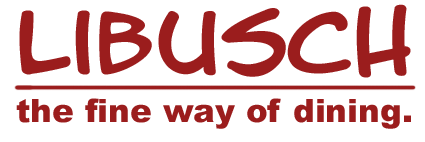Tablecloths Glossary
-
Atlas edge, Satin band
The satin band is the shiny, mostly circumferential stripe
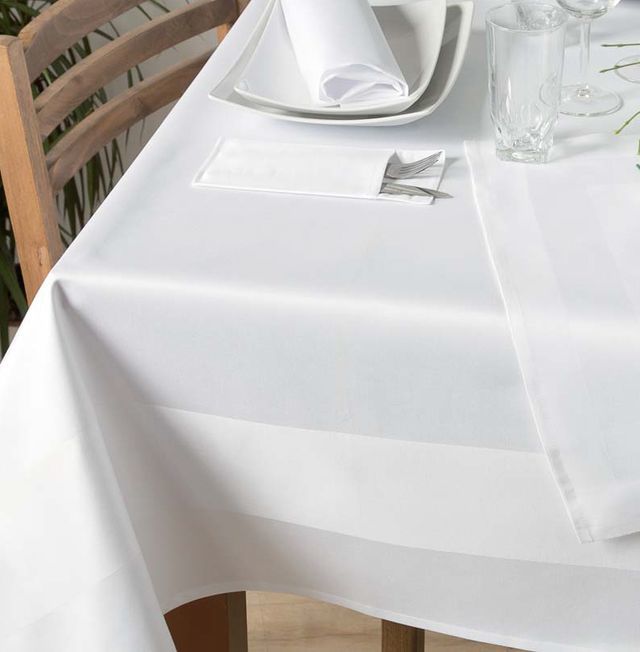 which is woven into the overhang of the tablecloth. The width of this strip varies, but is usually between 10 cm and 20 cm. Sometimes the atlas edge is also called satin band or atlas strip. The satin weave is one of the basic weaves of fabrics, along with the canvas and body weave. With the satin binding, the binding points are evenly distributed and do not touch each other, so that a more or less shiny, structureless surface is created depending on the type of fiber. This is especially nice for tablecloths and cloth napkins with atlas edge / satin band.
which is woven into the overhang of the tablecloth. The width of this strip varies, but is usually between 10 cm and 20 cm. Sometimes the atlas edge is also called satin band or atlas strip. The satin weave is one of the basic weaves of fabrics, along with the canvas and body weave. With the satin binding, the binding points are evenly distributed and do not touch each other, so that a more or less shiny, structureless surface is created depending on the type of fiber. This is especially nice for tablecloths and cloth napkins with atlas edge / satin band. -
Cotton
Many tablecloths today are made from cotton, a natural fiber extracted from the seed hairs of cotton bushes. The fibers used for tablecloths are usually spun into thin threads and are highly absorbent. Cotton fabrics as a whole are skin-friendly and therefore extremely popular with allergy sufferers. Cotton fabrics and thus also cotton tablecloths have numerous other positive properties, including high resistance of the tablecloths to mechanical and chemical influences, high tensile strength of the tablecloths, high wet strength and high abrasion resistance of the tablecloths. In addition, cotton is easy to clean, can be washed very hot (heat-resistant) even during numerous washing cycles and also has excellent dyeing properties. A yellowing occurs with dry cotton with approximately 160 degrees, only with approximately 250 degrees it becomes brown. Cotton tablecloths are appreciated mainly for their naturalness and pleasant fabric properties - unlike polyester tablecloths.
-
Mitred corner, envelope edge
Mitred corners or envelope corners are the diagonal seams on hem corners as they are often used, for example, with tablecloths, napkins, table toppers or table runners. The diagonal seams run in the direction of the center of the tablecloth and look similar to the back of an envelope. The hem turn is usually several centimeters wide. The fabric corners are folded, cut and sewn diagonally from the lace to the hem width. Table linen with mitred corners or envelope corners looks very fine and clean and looks very noble. Such envelope corners are particularly popular for linen tablecloths and linen napkins. A letter corner can only decorate the corner seam of a square tablecloth, round or oval tablecloths never have mitred corners, they are hemmed all around.
-
Damask

In tablecloth vocabulary, damask refers to a woven fabric with a woven pattern. Damask tablecloths usually impress with a beautiful light reflection of the pattern. Damask patterns in tablecloths are not bound to special fibers/fabrics, but are mostly made from mercerised cotton, less often from silk or chemical fibers. In the tablecloth-shop.libusch.de you will exclusively find damask tablecloths made of pure 100 percent cotton or cotton-linen blends. The damask pattern in the fabric of damask tablecloths is created by alternating different atlas bindings. Most damask patterns can be found on plain fabrics and look very discreet. They are particularly visible with oblique incidence of light. Especially table linen with an elaborate damask pattern looks very noble and stylish. Among the most important patterns that have always adorned damask tablecloths count floral elements and motifs, especially flowers, blossoms and leaves, which give tablecloths a fresh and delicate elegance. For this you also see the matching article damask at Wikipedia.
-
Shrinkage
In the tablecloth vocabulary, the shrinking process of brand-new tablecloths during washing is referred to as shrinkage. Depending on the quality of the table linen, the gap is 5-8 percent. This should be taken into account when choosing the size of a tablecloth. However, many tablecloths, especially our damask tablecloths, have always been a few centimetres larger than indicated in order to limit this entry. If you have any questions, please contact us at +49 251-60656913.
-
Fabric
In tablecloth vocabulary, fabric is the term used to describe manually or machine-made products that come from a weaving mill, e. g. cloth, velvet, linen, damask and other textile products with at least two right-angled crossed thread systems. The threads that run lengthwise in tablecloths and fabric napkins are generally called warp or warp threads, the cross threads are called weft or weft threads. The threads are connected to each other in a cross-hair in different rhythms. In order to achieve the greatest possible strength of a fabric and thus of a tablecloth, the warp and weft threads are woven as densely as possible. This gives, for example, a high-quality tablecloth a pleasantly firm and non-slip materiality, which then also leads to a longer service life of the tablecloth.
-
Half linen
In connection with tablecloths or napkins, half-linen means smooth or patterned fabrics consisting of flax and cotton yarns, each in warp or weft. The proportion of linen used for half-linen must be at least 40 per cent, which is the standard for half-linen tablecloths.
-
Hemstitch
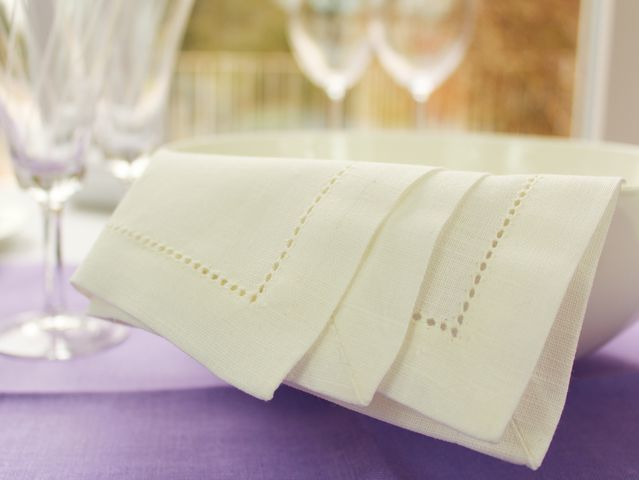
For many tablecloths and napkins hemstitches are used. A hemstitch is a decorative seam in fabrics, such as tablecloths or fabric napkins, which is created by pulling out warp and weft threads. For tablecloths, linen fabrics are particularly suitable for hemstitches. For a hemstitch, pull out two to eight threads in only one direction. The subsequent overstitching of the exposed thread webs results in a wide variety of patterns, depending on how the thread webs are bundled or plugged. Linen embroidery thread or a cotton embroidery thread can be used as embroidery thread. For simple hemstitches, the thickness of the embroidery thread should be approximately equal to the thickness of the fabric thread. Hemstitch tablecloths and hemstitch napkins are so popular because they look very classy and add elegance to any banquet table.
-
Home textiles
Home textiles are all goods that are used for interior design and decoration. These include, for example, tablecloths, blankets, bed linen, table linen, cloth napkins, curtains and drapes as well as window and bed hangings.
-
Jacquard weaving
Many tablecloths can also be found under the name Jacquard. Jacquard weaving is a weave named after J. M. Jaquard (1752-1834) with a complicated and elaborate pattern. The tablecloth motifs shown stand out against each other due to the contrast between the warp and weft atlas as well as different light reflections. The special weaving system automatically controls the individual warp threads in tablecloths for pattern formation. Jacquard is used, for example, for damask or brocade.
You can also see the matching article Jacquard Weaving at Wikipedia. -
Warp
Warp or warp threads are the threads running in the longitudinal direction of the fabric, for example of a tablecloth.
-
Linen
Besides cotton, linen is one of the most popular tablecloth fabrics and has experienced a real boom in the textile sector in recent years. Flax or linen fibre is a bast fibre and is obtained from the stems of the flax plant. In contrast to cotton, linen fibres form so-called bundles which consist of unconnected individual fibres. Linen is usually woven in the classic linen weave, but jacquard and other weave types are also very common in tablecloths. The linen fibre is easily separable and finely spinnable, making it suitable not only for table linen but also for clothing. In addition, linen is lint-free and less susceptible to dirt and bacteria, the fibre is bactericidal and antistatic due to its natural origin. Linen has a high tensile strength, is inelastic and therefore prone to creasing. However, the tear resistance makes the linen very durable and long-lasting; this is a good reason for many people to buy linen tablecloths. Linen tablecloths can maintain their quality and texture unchanged for decades. It is not uncommon for (linen) tablecloths still coming from grandmother's linen closet to be so popular with young people. Linen tablecloths are astonishingly resistant to washing lyes, detergents and cooking laundry. If you do not appreciate the noble wrinkle effect of linen, you can iron and mangle linen tablecloths at high temperatures. The prerequisite for this is that the tissue is still moist. The tumble dryer, on the other hand, should not be used with linen tablecloths, as excessive and dry heat damages the fabric. You should also be careful when bleaching linen, full bleaching leads to a high weight loss! The dyeing of linen, on the other hand, is possible.
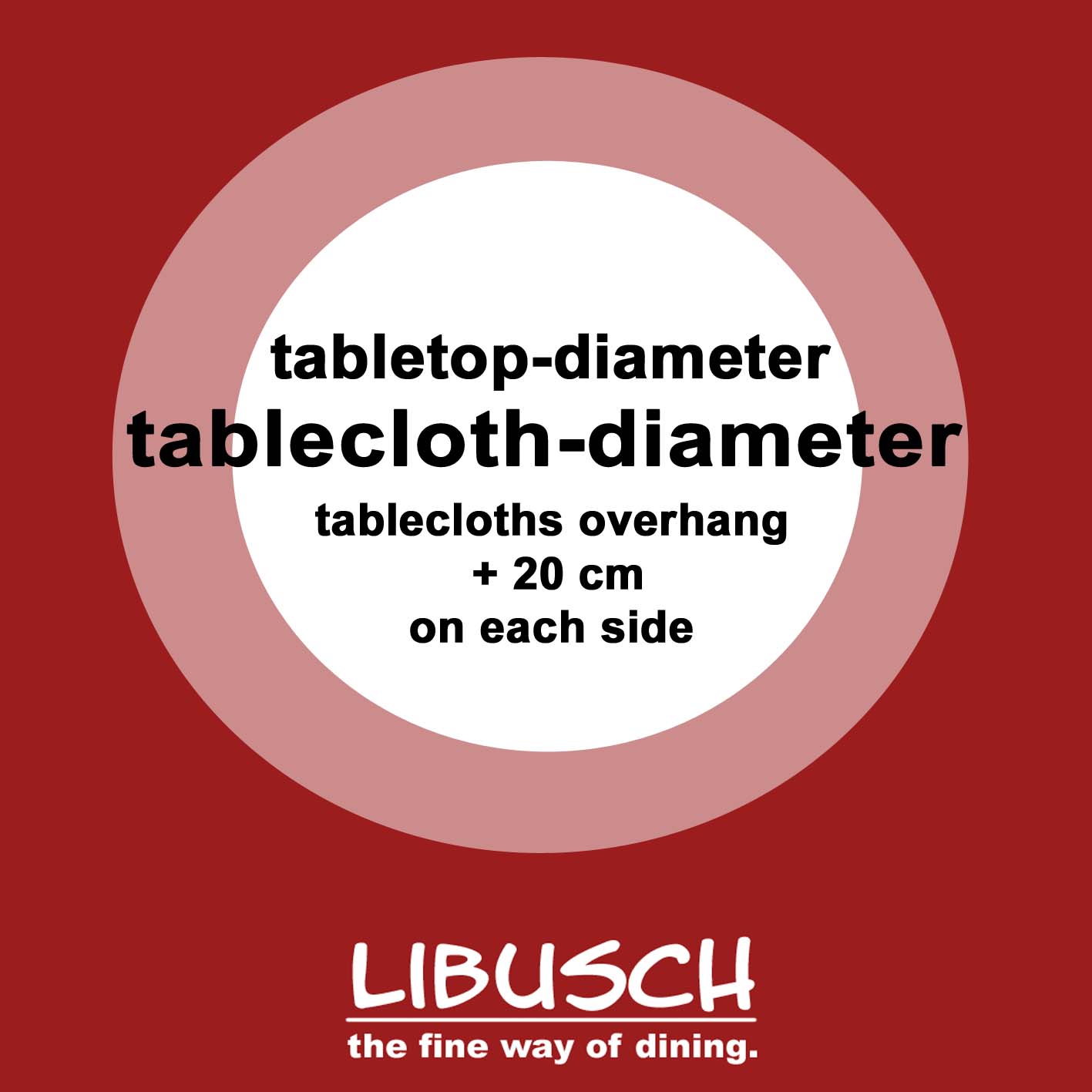
-
Tablecloths sizes / which tablecloth size do I need?
You can determine the optimum size of a tablecloth by taking the size of the tabletop and adding an overhang of approx. 20cm to max. 30cm on each side. This rule of thumb guarantees you a suitable tablecloth that is not too short and also not unreasonably long. If you choose a larger overhang, please consider the legroom of your guests! However, when calculating the size of a tablecloth, you should also take into account the shrinkage of the tablecloth during the first wash. This is about 5-8 percent. Our topics page, which explains in detail how to determine the right tablecloth size, can be found here.
-
Mercerise
In the technical vocabulary for table linen and tablecloths, the term mercerizing refers to a well-known finishing process which gives cotton fabrics a noble, silky and wash resisting sheen. In addition, mercerizing increases the dye absorption capacity, strength, elongation and elasticity of the tablecloths.
-
Molton
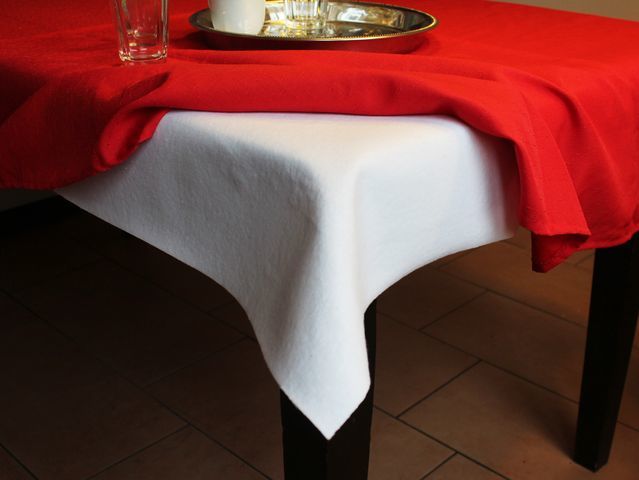
Molton is a light, loose cotton fabric that is sewn into tablecloths as an intermediate lining or used as a base for tablecloths. The table covering becomes thicker, tableware noises are dampened by Molton underlays. Molton pads also protect the table and create a pleasant feeling when sitting at the table due to the upholstery. The tablecloth also falls better at the edges on a table provided with a Molton pad.
-
Pastel colours
Tablecloths made of pastel colours - a real hit: Pastel colours are pale and light colours. They are characterised by a high proportion of white. Pastel tablecloths are so popular because they stand for bright, friendly and uncomplicated moods and appear very unobtrusive. Particularly popular are tablecloths in a delicate light blue, light green or light yellow. The colours can also be easily combined with each other. In daylight from above, they unfold a very delicate luminosity. However, in order to avoid monotony, you should use interesting colour accents through counterweights, e. g. through flowers or coloured dishes.
-
Weft
Weft or weft threads are threads in tablecloths or fabric napkins running in the transverse direction of the fabric.
-
Lace
Lace is the term used in table linen vocabulary to describe materials with an openwork pattern, usually in white, silk or cotton. Lace edges on tablecloths are particularly attractive and appealing, lace rooms spread a touch of romance.
-
Textile
A textile is, according to Wikipedia, a flexible material consisting of a composite of fibres, such as tablecloths, table topper, table runners or cloth napkins. The term textile refers to fibres, yarn, textile surfaces such as woven, knitted or crocheted fabrics and finished products. Today, the terms fabric and cloth are often used synonymously with the term textile. However, there are slight differences in the meaning of these words. Textiles in the actual sense are those materials which are made of fibres. Fabric or cloth, on the other hand, is material that forms a so-called textile surface by weaving, knitting, knitting or other joining of fibres.
-
Textile finishing
In order to manufacture textiles in terms of grip, appearance and use in such a way that they fulfil their intended purpose, the raw fibres are specially processed. Textile finishing usually includes the processes of pretreatment (e. g. bleaching), dyeing, printing if necessary, and additional finishing. The most important finishing processes include in detail: Bleaching, dyeing, optical brightening for brilliant white, finishing against fungi and bacteria, finishing against dirt, finishing against nodules and lint formation, softening or also a flame-retardant finishing.
-
Tablecloth
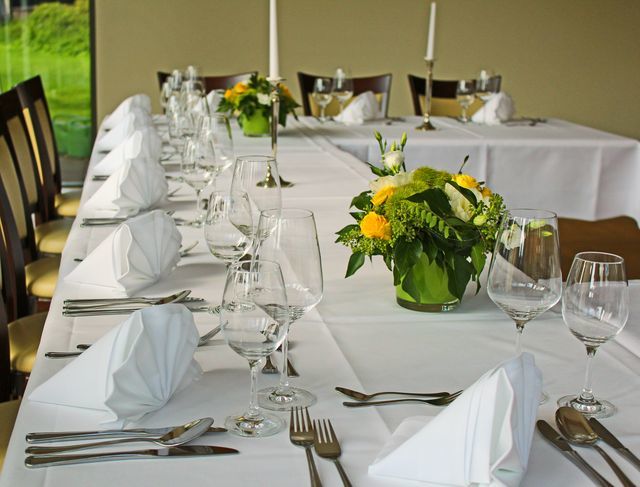
A tablecloth is a piece of cover adapted to the shape of a table, woven from textiles or manufactured from plastic. Tablecloths are used essentially for three reasons: firstly, for design reasons, because tablecloths shape the appearance of a living room and contribute to well-being; secondly, to protect the table from dirt and wear and tear; and thirdly, to cover an inferior table or its surface. You can also see the matching article Tablecloth at Wikipedia.
-
Two-ply
Two-ply is exclusively twisted yarns in warp and weft direction, i. e. two or more threads are twisted together before weaving. As a result, two-ply fabrics such as those we offer in our tablecloths and cloth napkins have a particularly high durability, optimum washing behaviour and, as a result, a long service life. Gastronomy tablecloths in particular are usually made of two-ply cotton, as they have to be particularly hard-wearing. Our tablecloths Padua with atlas edge are made of two-ply.
-
Yarn
Twisted yarns are produced by twisting two individual yarns together in the weaving mill. The strength of the weave of a tablecloth can thus be increased considerably, and the uniformity of the woven fabric is also improved.
